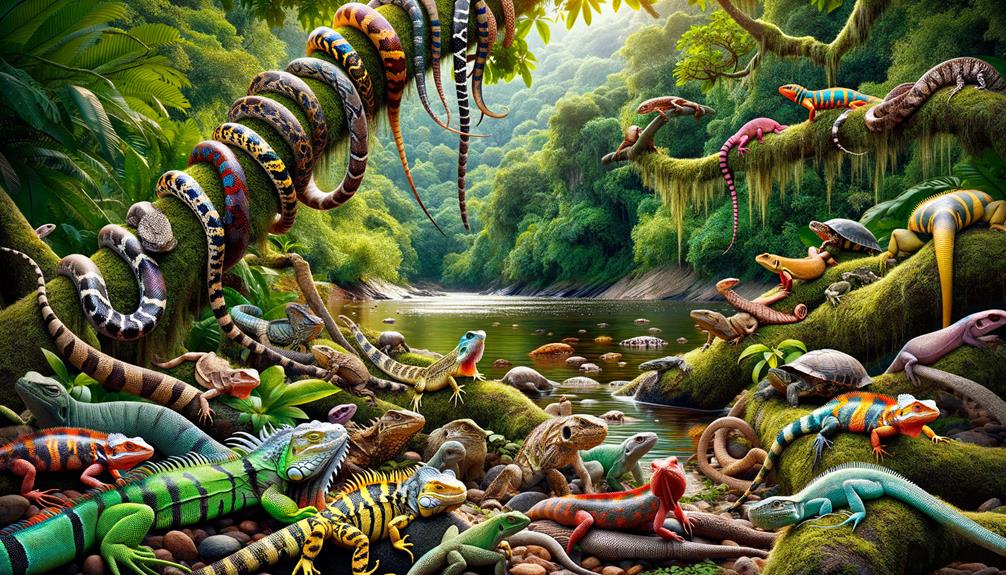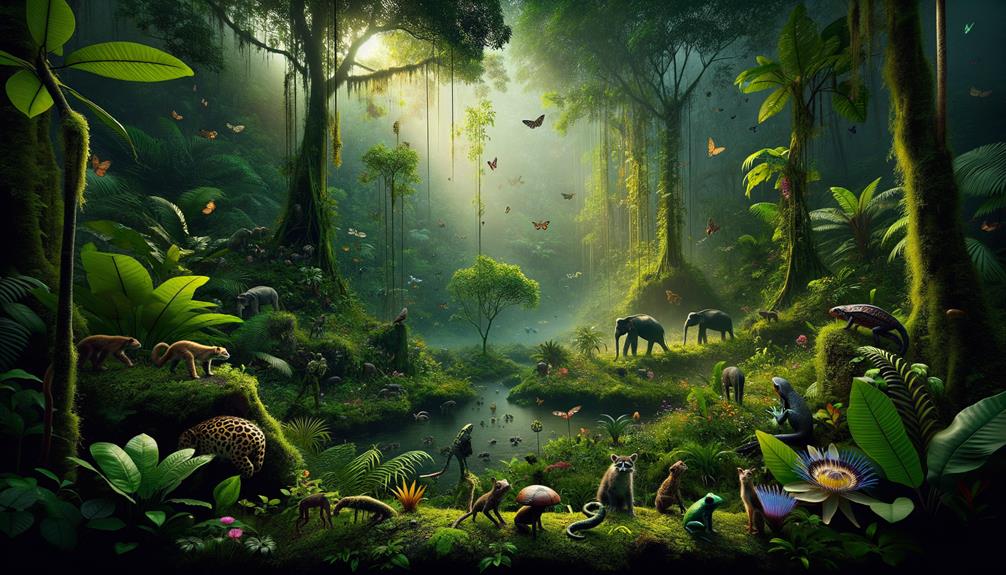In the Congo Basin, I’m drawn to the fascinating scaly creatures that inhabit this region. Nile crocodiles, which can grow up to 6 meters in length, patrol the waters, preying on fish, birds, and mammals. Within the Basin’s lush forests, over 120 species of snakes slither through the underbrush, including venomous black mambas and gaboon vipers. In the treetops, colorful chameleons like the Rwenzori three-horned chameleon expertly navigate their surroundings, changing color to blend in. On the forest floor, vibrant fire skinks and cunning African Savannah monitors dominate their territories. Unfortunately, these incredible creatures face threats from habitat loss and poaching, prompting conservation efforts to protect them. If you’re interested in learning more about the wonders of this ecosystem, let’s dive in.
Key Takeaways
The Congo Basin is home to an astonishing array of scaly inhabitants. Over 120 snake species, including the venomous black mamba and rhinoceros viper, thrive in this ecosystem. The Nile crocodile, the largest freshwater predator in Africa, plays a vital role in the Congo River’s delicate balance. Colorful chameleons, such as the Rwenzori three-horned chameleon, have mastered the art of camouflage and communication through their remarkable ability to change color. The region is also home to a diverse range of lizards and skinks, including the vibrant Fire Skink and dwarf crocodile lizard, which add to the Congo Basin’s rich biodiversity. However, these incredible creatures face numerous threats, including habitat destruction, poaching, and unsustainable forestry practices. Conservation efforts are underway to protect these species and their habitats, ensuring the long-term survival of the Congo Basin’s unique scaly inhabitants.
Nile Crocodiles
Nile crocodiles, the largest freshwater predators in Africa, can reach an astonishing 6 meters in length and dominate the waters of the Congo River Basin. As I venture into the dense, humid jungles of the Congo Basin, I’m struck by these magnificent creatures. Their presence reflects the intricate balance of the ecosystem here.
Nile crocodiles are adaptable hunters, preying on fish, birds, and mammals. This flexibility in their diet allows them to regulate prey populations effectively, preventing any single species from overwhelming the ecosystem. Additionally, their feeding habits contribute to nutrient cycling, enriching the waters of the Congo River and its tributaries with essential organic material.
However, these apex predators face significant threats. The expansion of human settlements and agricultural activities is shrinking their habitat. Hunting, driven by demand for their skin and meat, further jeopardizes their numbers. Human-wildlife conflict arises when crocodiles encroach on human territories, often leading to fatal encounters for both sides.
Despite these challenges, the Nile crocodile’s role within the Congo Basin remains vital. Their survival is crucial for maintaining the delicate balance of this vibrant and dynamic ecosystem.
Snakes of the Basin
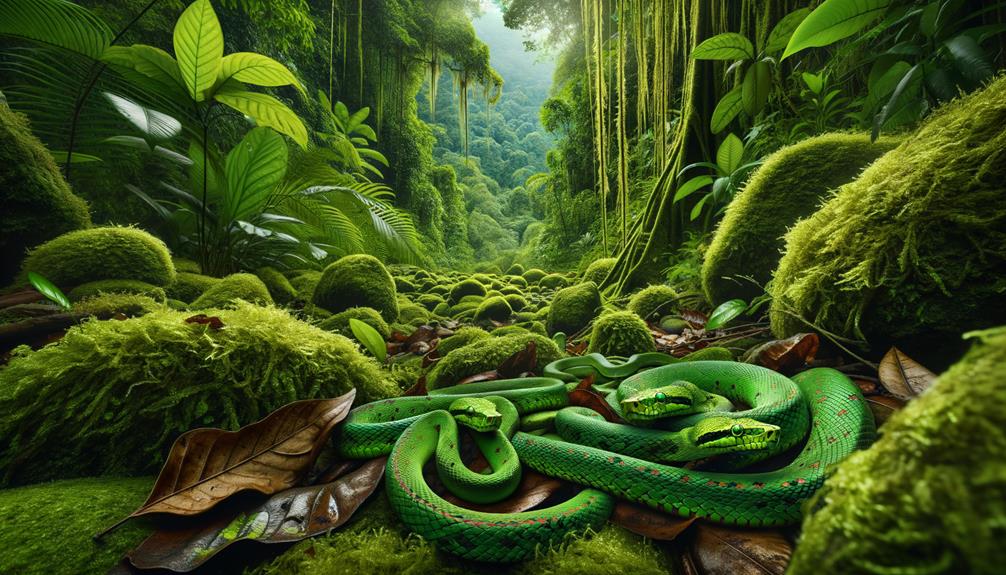
As I venture deeper into the heart of the Congo Basin, I’m struck by the fascinating group of reptiles that call this vast wilderness home: the snakes that slither through the dense forests and sprawling rainforest. With over 120 species, many found only in this region, the biodiversity is astounding. Each snake, from the elusive Gaboon viper to the agile Central African rock python, adds a unique thread to the rich tapestry of wildlife.
The presence of venomous snakes, such as the black mamba and rhinoceros viper, poses significant risks, but it also highlights the delicate balance of this ecosystem. These reptiles, while dangerous, play crucial roles in maintaining the health of the forest. Protecting this region is vital, not just for the snakes, but for the entire web of life they’re a part of.
| Snake | Habitat |
|---|---|
| Gaboon viper | Forests |
| Black mamba | Savannas, woodlands |
| Central African rock python | Throughout Basin |
| Green mamba | Rainforest |
Every snake I encounter serves as a reminder of the Congo Basin’s unparalleled biodiversity. The conservation of this region is critical, not only for the reptiles but for the entire spectrum of wildlife that calls this magnificent rainforest home.
Colorful Chameleons
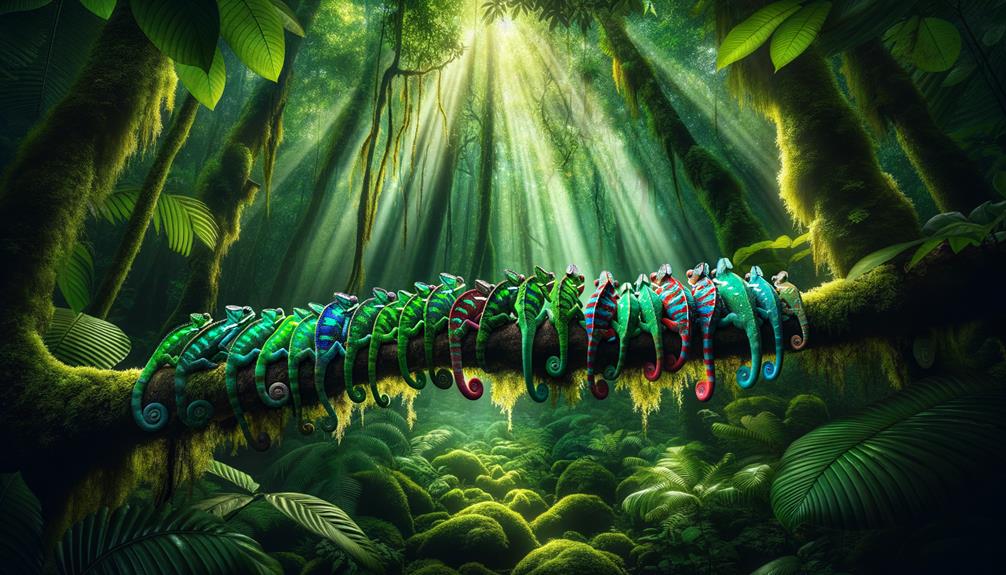
Venturing deeper into the Congo Basin, I’m struck by the vibrant, enigmatic chameleons that inhabit this lush ecosystem. These fascinating reptiles, like the Rwenzori three-horned chameleon and the Ruwenzori side-striped chameleon, have evolved to blend seamlessly into the dense forests. Their remarkable ability to change color isn’t just for camouflage; it’s also a vital communication tool, signaling their mood and intentions.
Perched on tree branches, chameleons showcase their unique foot structure, with two toes facing forward and two backward, providing an incredible grip. This adaptation allows them to navigate the forest canopy with remarkable ease. However, these remarkable creatures face significant threats. Deforestation and habitat loss have placed some chameleon species in the Congo Basin on the endangered species list.
It’s crucial we take action to preserve these incredible creatures. Establishing protected areas and promoting sustainable forestry practices are vital steps towards ensuring their survival. By safeguarding their habitat, we can help mitigate the devastating impacts of forest destruction and offer a refuge for these remarkable, color-changing creatures. The plight of the Congo Basin’s chameleons highlights the urgent need for concerted conservation efforts.
Lizards and Skinks
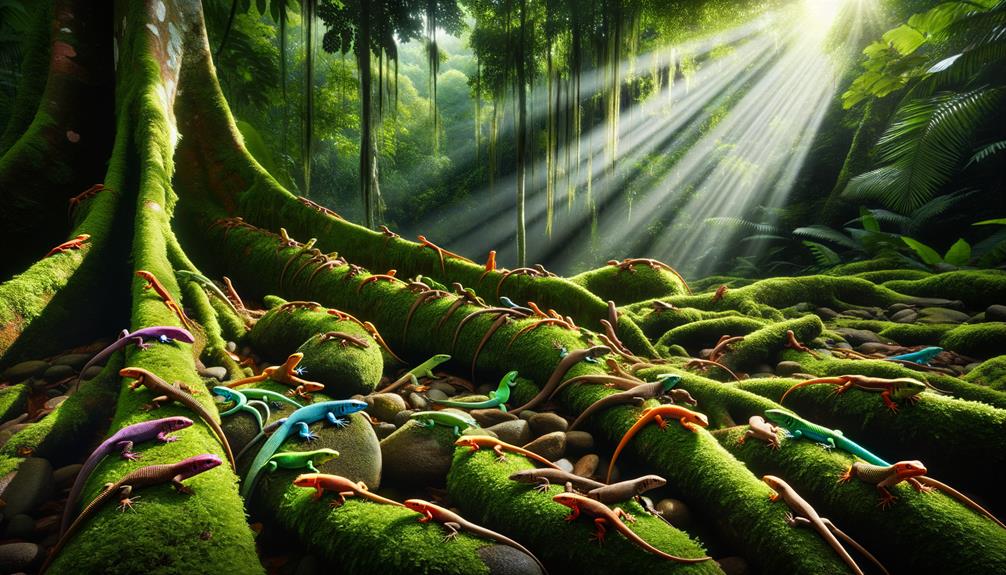
Exploring the Congo Basin, I stumble upon an astonishing variety of lizards and skinks, each species uniquely adapted to thrive in this rich and diverse ecosystem. The vibrant Fire Skink, with its striking red and yellow scales, darts through the underbrush, catching my eye. The Coecilia skink, more elusive, demonstrates its burrowing prowess, swiftly disappearing into the leaf litter.
Amidst the dense foliage, the African Savannah Monitor stands out, a formidable predator with a keen sense of its surroundings. Equally captivating is the Dwarf Crocodile Lizard, resembling a miniature dragon with its armored scales and agile movements.
- Fire Skink: A vibrant symbol of the Congo Basin’s lush biodiversity.
- Coecilia Skink: Expert burrower, thriving in the hidden domains of the forest floor.
- Dwarf Crocodile Lizard: A marvel of evolution, with its dragon-like appearance and agile movements.
- Cotswold Leaf-tailed Gecko: A master of camouflage, with its prehensile tail.
However, not all is idyllic. The Congolese Striped Skink, like many others, faces the dire threat of habitat loss due to deforestation. As these habitats fragment, the delicate balance of the ecosystem teeters, endangering the myriad lizard and skink species that call the Congo Basin home.
Conservation Efforts
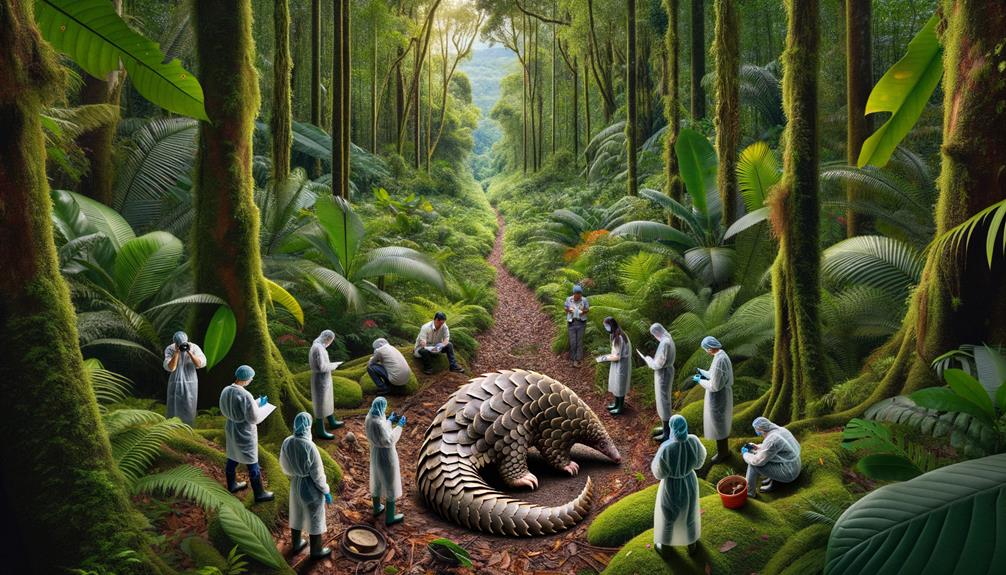
Conservation efforts in the Congo Basin are crucial for preserving its unique biodiversity. Numerous organizations, including the World Wildlife Fund, are working tirelessly to combat the threats faced by the region’s scaly inhabitants. The pangolin, often poached for its scales, is at the heart of both the illegal wildlife and bushmeat trades.
Authorities have seized and rehabilitated hundreds of pangolins, aiming to reduce consumer demand that drives this trade. Stricter law enforcement and penalties are part of a broader strategy to protect these enigmatic animals. Public awareness campaigns also play a vital role in changing attitudes towards the consumption of bushmeat and illegal wildlife.
In the Congo’s forests, local communities are being empowered to monitor and sustainably manage their peatland forest areas. This habitat is essential for pangolins and other threatened wildlife. Researchers are collaborating closely with Indigenous people, documenting traditional ecological knowledge and incorporating local perspectives into conservation strategies. By adopting these approaches, conservation efforts can ensure the survival of the Congo Basin’s scaly inhabitants, preserving their freedom to thrive in their natural environment.
Frequently Asked Questions
Who Lives in the Congo Basin?
In the Congo Basin, a rich tapestry of life unfolds, where pangolins, lizards, snakes, and crocodiles thrive. These creatures embody resilience and balance in ecosystems, despite the looming threats of poaching and habitat loss. They silently safeguard the delicate balance of nature.
Who Are the Indigenous People of the Congo Basin?
The indigenous people of the Congo Basin, including the BaAka, BaKa, BaMbuti, and Efe, have lived in harmony with the forest for over 50,000 years, relying on it for their survival. They have developed a sustainable way of life, using the forest’s resources for food, medicine, and shelter.
What Are the Characteristics of the Congo Basin?
The Congo Basin, a vast expanse of 500 million acres, comprises rivers, savannas, and swamps, making it a rich haven for biodiversity. This incredible ecosystem is home to an astonishing 10,000 plant species and supports the livelihoods of over 75 million people. Unfortunately, unsustainable practices threaten its very existence.
Who Are the Short Sized People Found in the Congo Basin in Africa?
The short-statured people living in the Congo Basin are the Pygmies. With an average height of under 150 cm, they’re remarkable for their traditional hunter-gatherer lifestyle. Indigenous groups like the Mbuti and Aka face significant challenges in modern times.


